All About Charming Brittany, France
Brittany, located in northwest France, is a region known for its stunning coastline, rich history, and unique culture. From the rugged cliffs and sandy beaches to the charming towns and cities, Brittany offers visitors a glimpse into a world that is distinctly different from the rest of France.
One of the main attractions of Brittany is its beautiful coastline, which stretches for over 2,000 kilometers. The region is home to some of the most picturesque beaches in France, including the popular seaside resorts of Saint-Malo, Dinard, and Quiberon. Visitors can enjoy a variety of water sports, such as surfing, windsurfing, and kiteboarding, or simply relax and soak up the sun.
We offer a Mont St. Michel Day Trip from Paris that stops in two of Brittany’s most interesting northern towns: Dinan and Saint Malo.
The region is also famous for its historic sites and landmarks, including the megalithic stone alignments at Carnac and the medieval fortress of Mont Saint-Michel. Other notable landmarks in the region include the Gothic-style Quimper Cathedral, the Chateau de Fougeres, and the walled city of Concarneau.
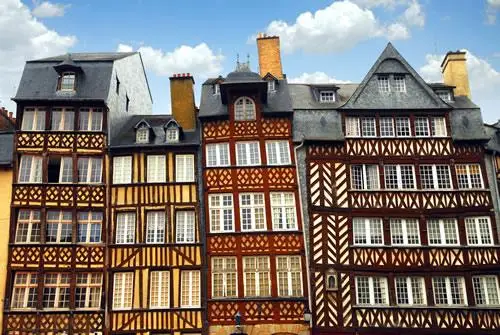
Brittany is also known for its unique culture and traditions. The region has its own language, Breton, which is closely related to Welsh and Cornish. Visitors can immerse themselves in the local culture by attending festivals and events, such as the Festival Interceltique de Lorient, which celebrates Celtic culture and music.
Food is also an important part of Brittany’s culture. The region is known for its seafood, including oysters, mussels, and scallops, as well as its savory buckwheat crepes, known as galettes. Visitors can sample these local delicacies at restaurants and markets throughout the region.
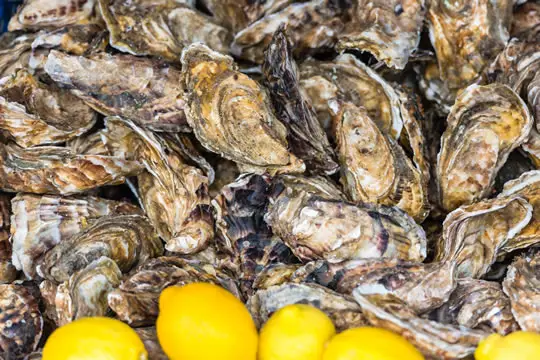
Brittany is easily accessible by train or car (the distance from Paris to Rennes is about 210 miles), and there are several airports in the region with direct flights from major cities in Europe. Visitors can also take a ferry from the UK to the port city of Saint-Malo.
In conclusion, Brittany is a must-visit destination for anyone traveling to France. Its stunning coastline, rich history, and unique culture make it a popular choice for tourists from around the world. Whether you’re looking to relax on the beach, explore historic landmarks, or immerse yourself in local culture and cuisine, Brittany has something for everyone.
Quick Facts About Brittany, France:
- The fastest tides in all of Europe can be found in Brittany. Be careful! When the tide comes in, it really comes in fast.
- In French “Brittany” is spelled “Bretagne”. Great Britain is known as “Grande Bretagne”.
- The capital of the region is the city of Rennes. Rennes has a population of over 200,000 people and is one of the major university towns in France.
Places of Interest in Brittany
Below is a list of some of the most popular places in the region. It is by no means a comprehensive list, but a great way to get started in planning a great trip to one of France’s most beautiful and somewhat underrated regions.
Pink Granite Coast – Sunset is the best time to explore the headland of L’Arcouest and the island of Bréhat and admire the expanses of sandy beaches and the rusty rock formations in splendid hues of pink which give this coast its name.
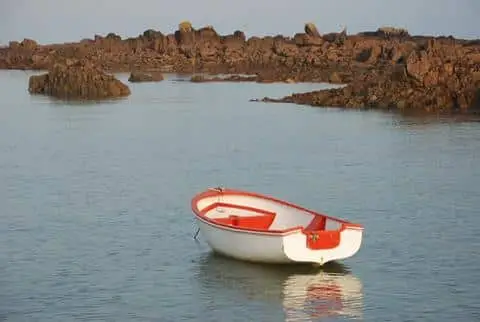
Charming Saint-Malo, France – Welcome to the charming village of Saint-Malo
This charming walled city of Saint-Malo is France’s gateway to the English channel, and an important ferry stop from Portsmouth, Poole and Weymouth in the U.K. Visitors also routinely head to the Channel Islands from the Saint Malo port. Proudly Breton, Saint-Malo even declared itself independent from France for a few short years in the late 1500’s.
Visit Saint Malo and Mont St. Michel with our one day trip from Paris
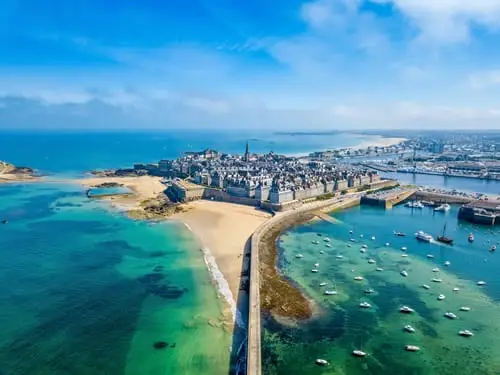
Saint Malo – From Pirates to Tourism
Saint-Malo has a rough pirate past which also brought wealth to the city, spoils from voyages over many centuries. A typical privateer (pirate) mansion-turned-museum is a must-stop in Saint-Malo, as are the many seafood restaurants featuring local oysters from nearby Cancale.
During WWII, the city was heavily bombarded, but was carefully rebuilt. The medieval center is intact, with quaint cobbled streets and half-timber architecture. Outside the walls, visitors will find pleasant 18th and 19th century-era streets, guesthouses and hotels, part of Saint-Malo’s development as a seaside resort, most often for Parisians, who today connect to the city via high speed TGV train.
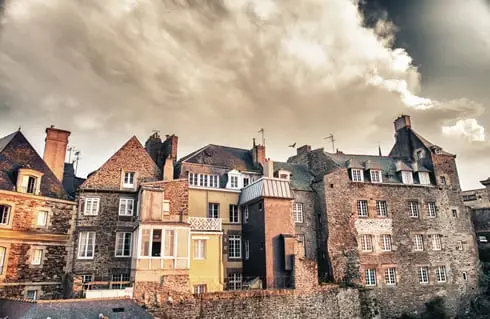
The French specialty of “thalassotherapy” (spas featuring a sea cure) are a focus for visitors, as well as the world class aquarium and nearby Mont Saint Michel.
The popular book All the Light That We Cannot See is set in Saint Malo during World War II.
The Parish Closes – The parish closes of Saint-Thégonnec, Guimiliau and Lampaul-Guimiliau, which were built as early as 1532, are symbols of France’s Catholic and Celtic heritage. These granite religious structures are an intricate mesh of skilled of craftsmanship and imagery. Churches, altarpieces and crosses are adorned with elves, gods and fairies carved in wood.
Rennes – Capital of Brittany – Rennes features remnants of typical timbered medieval architecture as well as two town centers, Place de l’Hôtel de Ville and Place du Parlement. One remains from the 15th century, and the other was built in stone after a massive fire swept through the city in the early 18th century.
Rennes is more of a college town than most French cities, gaining 80,000 students a year when the school year commences, and as such, it’s a little more of a meat and beer town than is the French cliche.
There is a cobblestone area not far from the medieval cathedral, as well as a yearly Festival Gourmande in September, in which local chefs create special menus and compete for honors.
Every Saturday Rennes hosts the second biggest market in all of France, with 300 purveyors arrayed at the historic Place des Lices. You’ll find Coucou de Rennes chickens, Petit Gris melons and Reinette apples, cider, shellfish and of course caramel candies and cookies made from famous Brittany salted butter.
Quimper and Pont-Aven – Located in the heart of traditional Brittany and flanked by the Odet and Steir rivers, Quimper is famous for its furnace ceramics which have been produced by skilled craftsmen since the 17th century. The Gothic Cathedral of Saint Corentin has exceptional 15th century stained glass windows. Pont-Aven, home to a former artist colony known as the “School of Pont-Aven” led by the painter Paul Gauguin, is a pretty market village of white houses and sloping riverbanks.
Carnac, Gulf of Morbihan – One of the foremost prehistoric centers, the seaside resort of Carnac is famed for its megalithic remains from the Neolithic period. In addition to 2792 menhirs, massive stones erected by tribes who inhabited the region before the arrival of the Gauls, the area is studded with burial places, semicircles, and tumuli.
Located ten miles off the southern coast of Brittany, Belle Ile (“Beautiful Island”) is the region’s largest. Buffeted by storms and fringed by rocky cliffs, it is an isolated natural paradise whose inhabitants are known for their hospitality. The medieval city of Vannes, at the head of the Gulf of Morbihan, is a perfect base from which to explore this magical inland sea and its many islands.
Cancale – Cancale lies along the coast to the east of Saint-Malo. It is a picturesque fishing village popular with visitors many of whom are drawn by its reputation as the “oyster capital” of the region. Though a small town, it is well served by a large number of restaurants, many specializing in seafood. One suggestion is to arrive in town around noon for a leisurely lunch in this picturesque and charming town.
There is a pleasant coastal path which permits a circular walk from the town to the Pointe du Grouin with splendid views across the bay towards Mont Saint Michel. Eugène Feyen painted Cancale and the inhabitants with the oyster-picking Cancalaises for several decades around 1865–1908. Vincent van Gogh wrote that “Feyen is one of the few painters whose pictures intimate modern life as it is really, and does not turn it into fashion plates”.
Museums in Brittany – Brittany has some great museums including the Musee de prehistoire (prehistory museum) in Carnac. The Musee de Pont-Aven (Pont-Aven museum) which features exhibits from the famous School of Pont-Aven in the charming town of Pont-Aven where artist Paul Gauguin lived. Musee des Beaux Arts (Fine Arts Museum) in Quimper which features a great collection of art from the 17th-20th centuries. The Musee de Bretagne/Musee des Beaux Arts (Brittany Museum & Fine Arts Museum) which retraces the region’s history with displays of costumes, models, porcelain, furniture and statues as well as a collection of fine art including works by Rubens and Picasso.
Castles in Brittany – Like almost every region of France, Brittany has its share of castles. The main ones are: Fort La-Latte in Frehel – Fortified chateau from 14th and 15th century overlooking the sea. Chateau de Josselin-Musee de Poupee in Josselin – Remarkable doll museum located in the former stables of the impressive Josselin Chateau. Chateau de Kerjean in Saint-Vougay – Formidable fortress and at the same time a stately home. Rustic grounds covering 50 acres and a Renaissance fountain.
Chateau de Comper-en-Broceliande in Concoret – Ramparts in red schist rock. The waters of the “Grand Etang” conceal the crystal palace built for Viviane, lady of the lake, by Merlin the magician.
Getting to Brittany
By car – Travel by highway from Paris to Le Mans and then to Rennes. From Rennes, travel toward Brest, Vannes, or Quimper.
By train – Daily from Paris Gare Montparnasse or select trains from Charles de Gaulle airport: 2-3 Hours to the regional capital of Rennes.
By air – Air France offers flights from Charles de Gaulle or Orly to Rennes, Quimper, Brest, Lorient, and Saint Brieuc. Flights are also available from London to Rennes, Brest and Dinard.
By boat – offers many options to travel from Ireland or the United Kingdom to Brittany.
Day Trips From Paris – See Mont St. Michel and More
Book our very popular one day trip from Paris to Brittany and Mont St. Michel. Stops include Dinan, St. Malo and Mont Saint Michel. We also offer an exceptional overnight trip from Paris to Brittany.
More Information About Brittany, France
- Our Travelogue: The Brittany Coast by Car
- The Brittany Tourist Office website